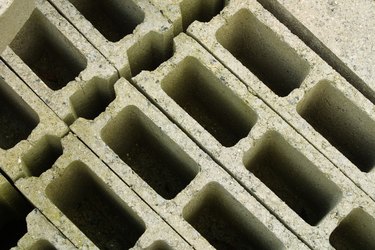
The steps to building your own cinderblock shower vary considerably depending on the type of cinderblock shower you want. Constructing a cinderblock shower in a bathroom, for instance, is easier than building a shower stall from scratch outside of the home. Building a cinderblock shower stall includes working with concrete blocks, building a shower base, designing your shower, creating a base, plumbing and more.
Working with Cinderblocks
Video of the Day
Before beginning construction on a cinderblock shower, familiarize yourself with concrete block masonry. Technically, cinderblocks are concrete blocks with cinders in them. You need to use mortar to adhere cinderblocks to one another. For a shower, you also need waterproof caulk or sealant to prevent water from leaking through the walls of the shower. Visit a hardware store to purchase mortar designed for use with cinderblocks in moist environments and to find waterproof caulk or sealant that works with concrete. Remember that building with cinderblocks is more difficult that simply stacking them on top of one another.
Video of the Day
Design and Preparation
As with any type of construction, you should create a complete design for your cinderblock shower before beginning the building process. This entails choosing a style of shower, such as freestanding or built-in, and a shape. Websites such as MSN Real Estate provide photographic slideshows of different indoor and outdoor shower designs. After deciding upon a design, create a detailed drawing of your shower, including dimensions, plumbing lines and the number of cinderblocks you need. Collect the needed materials, such as cinderblocks, mortar, trowel, sealant, caulk and, if needed, a shower pan, metal lath, showerhead, valve and pipes. Always check local building codes, and acquire any necessary permits before beginning.
Building a Base
Build your base before building anything else. If you're working outside, you can use a paved surface, the ground or a perforated bucket filled with stones for a base. When building inside the home, you need a proper base to prevent moisture damage to your house, and cinderblocks do not provide a proper base. For a homemade base, begin by installing a layer of metal lath and mortar on your shower floor. Install a shower pan made of polyvinyl chloride (PVC) or chlorinated polyethylene (CPE) on top of this for waterproofing. Apply more lath and mortar, and then put in your shower floor. Leave an opening in each of these layers for your shower drain. Alternatively, you can purchase a prefabricated shower pan from a manufacturer.
Plumbing
When building in a bathroom, plumbing considerations for a shower stall often involve nothing more than affixing a showerhead to existing pipes and installing a drain in your shower floor. When building an outdoor shower or a shower in an area without plumbing, such as the basement, you need to create a new plumbing line to feed your shower. To do this, contact a plumber. You can install a new plumbing line yourself, but unless you have experience in this work and know all local plumbing codes, you should avoid it. When purchasing pipes, fixtures and a valve, ask for standard shower equipment at a hardware store.
Putting It All Together
Avoid building cinderblock walls on top of a prefabricated shower pan. Cinderblocks are heavy and probably will smash your pan. Rather, build walls around your pan. Use your waterproof caulk or sealant at the juncture of the wall or the pan. You can build a homemade shower base into a concrete structure by attaching cinderblocks to the rim of the base using mortar. Always install your plumbing before you begin building concrete block walls, and check local building codes for cinderblock approval ratings before starting. If you're unsure about anything, such as attaching your cinderblock shower walls to a wood frame using lath and mortar, consult an engineer or contractor.